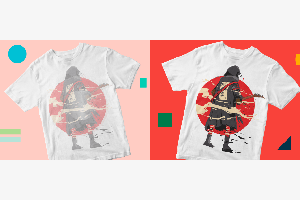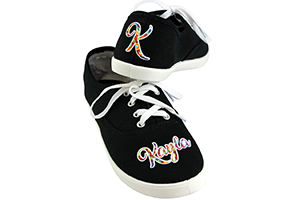October 7, 2013
Allover print sublimation (AOPS) is, well, all over the place. Of course it is a trendy application on T-shirts and V-necks seen in the wholesale decorated apparel marketplace. But from burnout garments, poly-performance tops and mixed martial arts (MMA) gear to hoodies and dresses, the popularity of AOPS is rising. If you have not seen it as a new source of potential revenue, you may want to look one more time.
It’s not just enjoying success in the imprintables market. Walk into Macy’s, Belk, H&M or just about any other major clothing retailer and you will see some apparel decorated with sublimation in the store. There are multiple brands offering different types of garments for this process. The topic has been well covered in Impressions and at the Imprinted Sportswear Shows (ISS), but it has grown and changed in the past couple of seasons.
Garment decorators are getting more and more requests for allover sublimation, and declining the opportunity could have long-term ramifications. Many people are predicting it will only increase in popularity from here on out.
No matter what type of AOPS you plan to do, there are several things you will need. At a bare minimum, you will need sublimation paper, an industrial (a.k.a. large) heat press and the right garments for your target customer.
You also will need the know-how to do it properly. So let’s get started and cover a couple of important areas.
OFFSET VS. DIGITAL
SUBLIMATION
Offset sublimation is all about volume. The vast majority of sublimation prints in the marketplace are made with offset sublimation equipment. This machinery involves a major capital investment — more than $1 million when you factor in all the costs and expertise needed to operate the machinery.
Offset sublimation paper comes in several standard-sized sheets. It is not a continuous printing process and, as a result, it is regulated to specific output sizes. Offset paper comes in the following standard sizes: 391⁄2″ x 277⁄8″ and 42″ x 59″.
The offset option makes sense when you are in the volume business. Most offset printers do not want to do runs below 500 units, and they much prefer runs between 5,000 and 10,000. That is because they need to make plates for the printing process. The costs of offset prints are directly impacted by the amount being produced. The more you print, the lower the cost. More often than not, if you are dealing with large orders and volume is above 500 units of allover prints, offset will be involved and could be contracted out.
Digital sublimation, on the other hand, is all about custom smaller runs. Most people who are considering allover printing are looking at a digital printer for output. For the majority of us, the average order will be fewer than 500 units. If customization (by size or per shirt) is involved in your business plan, then digital is your only option.
GETTING STARTED
Develop A Militant Attitude: This approach should be about standard operating procedures, keeping your files in order and keeping a clean shop — that is the type of person you want to be if you are going to do sublimation profitably. Track everything so you can make sure you know your cost of goods sold, and general and administrative costs that are supporting sublimation. This is critical for profitability.
“Pick Me!” “Print On Me!”:
Everyone wants to offer you a sublimation printer, but your choice is only the beginning of the conversation — albeit a critical one. Buy equipment that is built well enough to do the job when no one is around. The best sublimation shops can do unattended, uninterrupted printing after the day is done.
There are plenty of entry-level systems that are great to start with, but they will quickly show their limitations in this area, which is critical for long-term profitability. If you cannot hit “print” and leave, you are not configured for success. Roland, Mimaki, Mutoh and Epson are a few industry brands you should investigate and consider.
Press The Shirt (And Dress): Buying your oversized heat press is a huge decision, and there are plenty of options here. “Top+Bottom Heat” and “Top Heat Only” is the major difference, and both can be profitable. You want a press that is big enough to do the largest shirts (or garments) you plan to press. Don’t forget about 2XL and 3XL apparel. If you can’t produce these larger sizes, you will have a major problem. There are too many presses to list, but Practix, Geo Knight & Co., AIT, Monte Antonio and Schuster all are players in the oversized heat press market.
PC Print Lock + RIP: A PC is required for AOPS. You will need a robust machine capable of driving the RIP software in which you also must invest. The PC brand does not matter. ErgoSoft and Wasatch are the two main RIPs on the market. Roland machines include a proprietary RIP that does a great job for its platform.
Design Zone: If you do not have design skills inside the building, you should not enter sublimation. This is a critical area. Without good art skills, you will find yourself frustrated. Clients, even the most organized ones, often still need graphical help. You can design on a Macintosh platform, but you must print in a PC environment.
Expertise: You need to have access to sublimation expertise. You need good profiles. You need color curves to maximize your printable gamut, and you also must know the best way to do workflow. You also need people who can help you with technical support issues. Most of these elements should come from the person who is selling you the equipment. If he doesn’t have the depth of knowledge you need, look for others who do. They are out there.
The opportunity to differentiate yourself with AOPS is real. But the investment is not small. Doing this correctly requires at least a $40,000 commitment, and possibly more if you want premium equipment. Anything less is suspect. But the increase in demand for this type of output continues to grow and the market for performance fabrics also is ever-increasing at this time.
For those of you wondering if it is time to get in or if it is a passing fad, no one really knows. But there is a significant argument for believing in the long-term importance of large-format sublimation, even if AOPS will wane in popularity. The diversity of products that can be sublimated is without equal in digital printing. While cotton will forever be the fabric of our lives, polyester is gaining massive market space from athletics to corporate gear.
Christopher Bernat is chief revenue officer at Vapor Apparel. He is a current board member of SGIA, and he speaks and writes on sublimation and mass customization for SGIA, ISS, FESPA and Dig South. For more information or to comment on this article, email Chris at chris@vaporapparel.com.
Why Don’t You Print Like I Do?
AOPS is driving a lot of business for a lot of different companies, from online retailers offering as few as one shirt to offset printers who offer huge volume solutions, to bricks-and-mortar retailers. Let’s take a look at three companies and their plans for success.
JAKPRINTS INC., Cleveland
TARGET MARKET: Allover Dye Sub Market
Focused on giving online consumers a simple process, the company has grown substantially in the past 12 months.“We see allover sublimation as a great solution for customized apparel,” says Nick DeTamaso, COO. “We see significant growth in this area as our customers become more successful with their creative lines in the marketplace.”
TREVCO INC., Troy, Mich.
TARGET MARKET: Licensing Retailers
A leader in on-demand licensed apparel for years, Trevco recently has seen the need to add AOPS.
“We are gearing up for it in a big way,” says Jim George, founder and CEO. “It is being driven by customer demand and our desire to differentiate ourselves from other licensees. The company has a whole host of content from ‘Superman’ to the Showtime original series, ‘Dexter.’ We see sublimation as a great way to increase the number of products our current customers purchase from us.”
“We have seen demand for short-run licensed products growing,” says Tom Richmond, production manager. “We entered this market on the direct-to-garment platform for our on-demand cotton production. And now sublimation is going to build off of that base of customers. We are excited to expand the design options our clients have.”
DONRAY PRINTING, Parsippany, N.J.
TARGET MARKET: Volume Garment Buyers
With more than 27 years of experience in offset (long-run) sublimation printing, Ray Ferriola is seeing an uptick in demand after much of Donray Printing’s business had moved offshore.
“We are starting to focus on the increase in domestic performance apparel,” he says. “Time to market is becoming more important and the cost of doing things offshore is increasing.”
Donray Printing is focused on volume. When clothing lines begin to exceed 100s and move into 1,000s per design, the company is a trusted resource in the metropolitan New York area.
April 12, 2023 | Sublimation
As you work toward becoming an experienced dye-sublimation apparel, general merch or customized promotional items decorator, you may come across one or more obstacles, like your transfers coming out blurry, dull or faded.
FULL STORY
June 1, 2022 | Sublimation
How many times have you wished that you could sublimate a product that wasn’t polymer-based or polymer-coated.
FULL STORY
October 8, 2021 | Sublimation
I think the philosophy of lagniappe should be taught at every school and practiced by every business. A French word meaning “unexpected extra gift,” lagniappe often is used in Louisiana. In fact, sublimation decoration is a fantastic example of this.
FULL STORY




